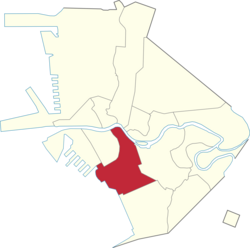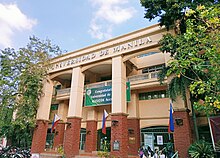Ermita
 From Wikipedia - Reading time: 13 min
From Wikipedia - Reading time: 13 min
This article needs additional citations for verification. (June 2009) |
Ermita | |
|---|---|
District of Manila | |
 The skyline of Ermita with the National Museum of Natural History in the foreground | |
 Location within City of Manila | |
 | |
| Country | Philippines |
| Region | National Capital Region |
| City | Manila |
| District | Part of the 5th district of Manila |
| Barangays | 13 |
| Area | |
• Total | 1.59 km2 (0.61 sq mi) |
| Population (2020)[1] | |
• Total | 19,189 |
| • Density | 12,000/km2 (31,000/sq mi) |
| Time zone | UTC+08:00 (Philippine Standard Time) |
| ZIP code | 1000 (Manila CPO) |
| Area codes | 02 |
Ermita is a district in central Manila, Philippines. It is a significant center of finance, education, culture, and commerce. Ermita serves as the civic center of Manila, bearing the seat of city government and a large portion of the area's employment, business, and entertainment activities.
Private and government offices, museums, and universities thrive in Ermita. It is also home to several tourist attractions and landmarks, including Rizal Park.
Ermita and its neighboring district Malate were originally posh neighborhoods for Manila's high society during the early 20th century, where large, grandiose mansions once stood. Ermita and its surroundings were heavily bombed and flattened during the Second World War after it became a battleground during the Manila massacre. After the war, Ermita and its twin district, Malate, had undergone commercialization, shifting from a sprawling upscale suburb to a commercial district.
History
[edit]This section needs additional citations for verification. (June 2009) |

Kingdom of Luzon
[edit]The town of Ermita was originally called Lagyo in Tagalog. It was close to Manila.
Spanish rule (1570–1898)
[edit]During Spanish rule, the town was recorded by Miguel de Loarca in 1582:
On the coast near Manila are Laguo, Malahat, Longalo, Palañac, Vakol, Minacaya, and Cavite. All these settlements are in the neighborhood of Cavite, and belong to his Majesty, to whom they pay tribute.
— Miguel de Loarca, Relacion de Yslas Filipinas (1582)[2]
Lagyo was re-christened in the 17th century as La Hermita (Spanish for "the hermitage") after the fact that a Mexican hermit resided in the area and on this site was built a hermitage housing an image of the Virgin Mary known as the Nuestra Señora de Guia (Our Lady of Guidance). The hermit-priest's name was Juan Fernandez de Leon, who was a hermit in Mexico before relocating to Manila.[3]
The hermitage has since evolved into Ermita Church, rebuilt several times since the early 17th century.[4] During the Spanish evacuation of Ternate in present-day Indonesia, the 200 families of mixed Mexican-Filipino-Spanish and Papuan-Indonesian-Portuguese descent who had ruled over the Christianized Sultanate of Ternate and included their sultan who converted, were relocated to Ternate, Cavite, and Ermita, Manila.[5]
By the 19th century, although still considered as an "arrabal ", which refers to a rural area, urban expansion had slowly reached the northern portion of the district mainly due to the development of the Luneta, also called Bagumbayan, as a promenade at the coast of Manila Bay. The district also saw the construction of the Manila Observatory by Father Federico Faura during the early 1890s. It was once located on a street now named after Fr. Faura himself. Ermita then developed a creole language based on Spanish called Ermiteño, which eventually became extinct after the devastation of the Second World War. However, it still has a surviving cousin language spoken in nearby Cavite.[citation needed]
American and Commonwealth era (1900–1944)
[edit]
Ermita gained renewed prominence during the American and Commonwealth era. As part of Daniel Burnham's plans for Manila, influenced by the City Beautiful movement during the early 1900s, Ermita, alongside Intramuros' surrounding areas, had undergone a drastic redevelopment from being the outskirts to urban districts. In 1901, with the chartering of Manila,[6] Ermita would be absorbed by the city of Manila when its area was expanded outside the walled Intramuros.
Burnham envisioned the district, especially in the northern portion, to be the center of the Philippine government, redeveloping Luneta into a grand park patterned after that of the National Mall in Washington, D.C. Government buildings housing the legislative, executive and judicial branches were planned to be located in the area. A proposed Philippine capitol was also planned to be built at the eastern tip of Luneta Park but never materialized.[7]

It also became known as the university district, containing the campuses and dormitories of the Philippine Normal University,[8] the University of the Philippines, the Ateneo de Manila, the Adamson University, the Assumption College and St. Paul College. The residential portion of Ermita was populated by American residents, who set up such establishments as the Army and Navy Club and the University Club.[9]
Aside from its universities and leisure clubs, Ermita district, as well as its adjacent district, Malate, which both happened to be facing Manila Bay, were once home to Manila's high society and were filled with large, gilded mansions. Manila's wealthiest families used to live in the twin suburbs.
One notable structure built was the Insular Ice Plant, designed by consulting architect Edgar K. Bourne, who was also the head of the Bureau of Architecture in 1902 (under the Philippine Commission).
Second World War (1942–1945)
[edit]In February 1945, during the 1945 Battle of Manila, Ermita was the scene of some of the most horrific massacres that occurred during the Second World War. The wife and four children of future President Elpidio Quirino were murdered in Ermita, as was Supreme Court Associate Justice Anacleto Diaz. Between 68% and 85% of Ermita was destroyed during the Battle of Manila, with an estimated total of 100,000 Filipino civilians killed within the city.[10]
Post-war era (1946–present)
[edit]After the war, the district slowly transformed from a residential area into a commercial area as the upper classes moved to other cities such as Quezon City and Makati.
Ermita was rebuilt after the devastation of the war. University life remained vibrant therein. However, as decades passed, Ermita started earning a reputation as the red-light district of Manila.[11] During the first term of Mayor Alfredo Lim, 1992–1998, efforts were made to "clean up" Ermita's image and reputation. However, a local city ordinance prohibiting the establishment of motels, lodging houses, and other similar establishments was later declared unconstitutional by the Supreme Court.[12] Nightlife in the area dwindled, though it later picked up with the help of the emergence of the nearby Malate district and the Roxas Boulevard revitalization efforts along Manila Bay.
Accessibility
[edit]
The district can be directly accessed by the main roads such as Roxas Boulevard, Padre Burgos Street, Taft Avenue and United Nations Avenue. Lawton Park N Ride, the city's main public transport hub, is located in the district along Padre Burgos Street, as well as the Manila Multimodal Terminal near the Pasig River.
The Manila Light Rail Transit System (LRT-1) follows Taft Avenue and stops at three stations in Ermita, namely Central Terminal station, United Nations station and Pedro Gil station.
Pasig River Ferry Service has a ferry station in the district named Lawton.
Facilities
[edit]

Culture, Heritage, History and Recreation
[edit]Rizal Park, a prominent feature of Ermita, is one of the largest urban public parks in the country and the location of the monument to the national hero José Rizal. It was the original site for Burnham's planned government center and the capitol building. Other sites of interest in Ermita include:
- National Museum of Fine Arts
- National Museum of Anthropology
- National Museum of Natural History
- National Library of the Philippines
- National Archives of the Philippines
- Museo Pambata
- Quirino Grandstand
- Manila Ocean Park
- Liwasang Bonifacio
- Arroceros Forest Park
- Bonifacio Shrine
- Mehan Garden
- Metropolitan Theater
- Manila Hotel
- The Masonic Temple of Ermita
- Philippine Independent Church
- San Vicente de Paul Church
- Ermita Church
Institutions
[edit]- Insurance Commission
- Manila Doctors Hospital
- Medical Center Manila
- Department of Justice (Philippines)
- National Bureau of Investigation
- Philippine General Hospital, the country's largest hospital
- Supreme Court of the Philippines
- Court of Appeals of the Philippines
- World Health Organization Western Pacific Region Headquarters
- Embassy of the United States
Education
[edit]
A number of educational institutions are also found in Ermita, including:
- University of the Philippines Manila
- Adamson University
- Emilio Aguinaldo College
- Santa Isabel College Manila
- Philippine Normal University
- Technological University of the Philippines
- Universidad de Manila (formerly the City College of Manila)
- Manila Science High School
- Araullo High School
Barangays
[edit]Ermita comprises 13 barangays numbered 659, 659-A, 660, 660-A, 661, 663, 663-A, 664, 666, 667, 668, 669, and 670.
Barangays 659 to 664 are part of Zone 71 of the City of Manila, while barangays 666 to 670 are part of Zone 72.
| Zone/Barangay | Land area (km2) | Population (2020 census) |
|---|---|---|
| Zone 71 | ||
| Barangay 659 | 0.1403 km2 | 361 |
| Barangay 659-A | 0.3553 km2 | 2,607 |
| Barangay 660 | 0.05628 km2 | 332 |
| Barangay 660-A | 0.1159 km2 | 2,457 |
| Barangay 661 | 0.1222 km2 | 441 |
| Barangay 663 | 0.05173 km2 | 604 |
| Barangay 663-A | 0.07525 km2 | 403 |
| Barangay 664 | 0.1429 km2 | 456 |
| Zone 72 | ||
| Barangay 666 | 0.6910 km2 | 810 |
| Barangay 667 | 0.1991 km2 | 2,371 |
| Barangay 668 | 0.1559 km2 | 2,645 |
| Barangay 669 | 0.2455 km2 | 2,928 |
| Barangay 670 | 0.1419 km2 | 2,774 |
In popular culture
[edit]- Ermita was referenced in pop/rock band Eraserheads's song Ang Huling El Bimbo from their 1995 studio album Cutterpillow.
References
[edit]- Aluit, Alfonso (1994). "The Christian City". By Sword and Fire: The Destruction of Manila in World War II 3 February – 3 March 1945. Philippines: National Commission for Culture and the Arts. pp. 85–89. ISBN 971-8521-10-0.
- ^ "2020 Census of Population and Housing Results" (PDF). Philippine Statistics Authority. August 16, 2021. Retrieved April 7, 2023.
- ^ Blair, Emma Helen; Robertson, James Alexander, eds. (1906). The Philippine Islands, 1493–1803. Vol. 5: 1582–1583. Arthur H. Clark Company. p. 83.
- ^ "Jesuits In The Philippines (1581–1768)" Page 132 "In 1591 there arrived in Manila a secular priest named Juan Fernandez de Leon. He had led a hermit's life in Mexico and planned to continue it in the Philippines. For this purpose he built himself a retreat near a wayside shrine just outside the city walls which was dedicated to Our Lady of Guidance, Nuestra Sehora de Guia. His hermitage later gave its name to the entire district, which is called Ermita to this day."
- ^ By Sword and Fire: The Destruction of Manila in World War II 3 February – 3 March 1945, p. 85-86
- ^ Zamboangueño Chavacano: Philippine Spanish Creole or Filipinized Spanish Creole? By Tyron Judes D. Casumpang (Page 3)
- ^ An act to incorporate the City of Manila (183). July 31, 1901. Retrieved June 6, 2022.
- ^ "(5) The Plan: Manila". Burnham in the Philippines.
- ^ pnu.edu.ph
- ^ By Sword and Fire: The Destruction of Manila in World War II 3 February – 3 March 1945, p. 89
- ^ By Sword and Fire: The Destruction of Manila in World War II 3 February – 3 March 1945, p. 405
- ^ Leo van der Velden, Tussen Prostituee en Maitresse, de Hospitality Girls van Ermita, Manila, 1982, ASC-VAZZOA Universiteit van Amsterdam https://hdl.handle.net/11653/book93585
- ^ G.R. No. 118127. April 12, 2005 (archived from the original on 2008-02-24)
 KSF
KSF